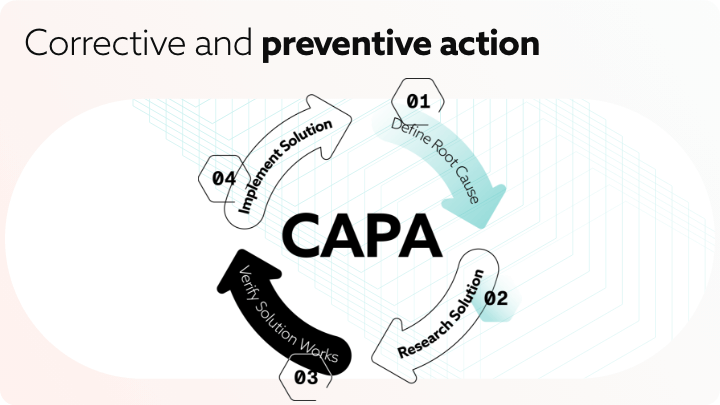During the years of increased demand and supply of services and products, companies try to develop their production processes for the better. This also includes a risk analysis of the industry’s problems.
The finding that deviations from any quality process result in a nonconformance or deviation—whether from complaints or process changes – must be documented. Moreover, as an indication of the company’s care and its pursuit of excellence, immediate control and corrective action should be taken.
In this article, we will review some key factors in the corrective and preventive action process. Its primary purpose is to ensure operational excellence and stop an unwanted event from happening again with strict quality management processes.
Introduction to Corrective and Preventive Actions (CAPA) Software
A corrective action aims to treat or eradicate the root cause of an error, such as non-conformity, that occurs in a quality process and stop it from happening again. This entails identifying and removing the underlying sources of the issue. The purpose of a preventative measure is to ensure that such non-conformities do not happen again.
Software for quality management systems called Corrective and Preventive Action (CAPA) is used to identify, look into, and correct product or process nonconformities while also preventing them from happening again. These software programs guarantee adherence to industry best practices and legal requirements by automating and streamlining the CAPA procedure.
Businesses operating in regulated sectors are required to manage corrective and preventative actions (CAPAs) through a systematic process. This method includes problem identification, root cause analysis, solution implementation, and verification. Businesses may manage this process and uphold compliance with CAPA management software.
To protect your company from severe regulatory concerns, you should carefully consider your options for CAPA software. We will take a deeper look into what a company’s CAPA management system should have in order to be adequate for the business and up to date with the regulatory requirements.
What is the Purpose of the CAPA Process?
The CAPA process is robust for improving a quality management system – QMS and avoiding future non-conformities. It is among the critical components of a robust QMS.
Life sciences manufacturers’ complaints, non-conformities, and out-of-specification results should all result in a CAPA file, yet the FDA still finds systematic issues with how they are handled. Managing corrective and preventive action activities is a big priority.
According to a passage from an FDA warning letter:
“ ….the investigation failed to establish a root cause, and your quality unit failed to ensure the implementation of adequate corrective actions to prevent future recurrence.”
A CAPA system’s main goals are to treat the root causes of non-conformities or deviations, prevent them from happening again, and eradicate any negative effects. The better an organization’s CAPA system is, the more resilient and efficient it should be. The CAPA process, which corresponds to phase four of the deviation management process, will be an ongoing improvement.
Phases of The Deviation Management Flow
As mentioned earlier, the CAPA processes correspond to phase 4 of the deviation management process. It is a resource-intensive activity used to achieve the organization’s quality goals.
All the phases are as follows:
- Phase 1. Deviation/non-conformity identification and reporting;
- Phase 2. Investigation and root-cause analysis;
- Phase 3. Risk assessment;
- Phase 4. Action Plan (CAPAs);
- Phase 5. CAPA effectiveness checks;
- Phase 6. Periodic reviews.
When you have an effective quality management system in place, you may use statistical techniques to gather and evaluate data regarding product and quality failure modes to identify recurrent quality issues. When necessary, keep in mind that data from several sources should be used to pinpoint and investigate the causes—phases 1 through 3.
When Do You Need CAPA
Among the situations when a CAPA might be required are:
- Change controls;
- Non-conformities;
- cGMP deviations;
- Complaints;
- Recalls;
- Product rejections;
- Internal and or external audit observations;
- Regulatory inspections;
- Staff observations;
- Trending data;
- Continuous improvement initiatives out-of-specification results;
- Out-of-trend results;
- Product quality reviews;
Organizations may systematically address these problems and ensure continual improvement, regulatory compliance, and the upholding of high standards by putting in place a strong CAPA system.
Key Features and Functionality of CAPA Software Solutions
CAPA software offers useful and easy-to-understand and implement corrective functions that aim to support the organization’s work process and prevent occurrence of potential product and quality problems.
- Non-conformities record: Collecting and analyzing data, and tracking and recording incidents of non-conformity with products or processes, such as supplier notifications, internal audits, and customer complaints, lead to quality improvements.
- Root cause analysis: An essential factor of the CAPA system is performing a thorough root cause analysis, which can use frameworks such as 8D, 5W-2H, or WCM to determine the root causes of non-conformities. CAPA software also helps automate the data collection, process, and report steps of the investigative process.
- Corrective action planning: Corrective and preventive software sets and creates plans for corrective actions that include duties, deadlines, and responsible persons. Robust CAPA systems ensure compliance with legal specifications, reducing the potential for fines, penalties, and other enforcement measures.
- Planning preventive actions: Preventive measures can be created and implemented to get rid of the underlying problems and stop them from happening again. By efficiently solving problems and providing an easy-to-follow workflow management environment, the CAPA system contributes to maintaining and increasing customer happiness. Simplified CAPA procedures can lead to lower non-conformance costs and other operational inefficiencies.
- Cooperation and approval: CAPA software could improve business operations, teamwork, and communication between different departments in the company. Employers can be more confident that all parties involved are informed and in agreement through their own records of CAPA reviews and approvals. The system creates dashboards and reports to monitor CAPA performance, detect trends, and measure achievements.
- Training and reporting: Reporting and documentation are the basis upon which future training and knowledge manuals can be built. They are key components of CAPA systems, thus additionally guaranteeing the normal work process with a reduced risk of causing problems.
Last but not least – a strong CAPA system is user-friendly. It reduces risk, ensures continuous improvement, and improves overall quality control.
What Can Cause the CAPA System to Be Ineffective, and How to Prevent It?
The inefficient tracking of corrective actions in your QMS can contribute to the ineffectiveness of your CAPA system.
As you are already aware, there are manual, computerized, and hybrid methods for managing data. It must be taken into consideration that because manual systems are typically disconnected and overseen by multiple individuals, they can be challenging to administer.
A few of the processes that rely on various managers are:
- Manufacturing;
- Quality control;
- Auditing;
- Complaints;
- Research and development.
These procedures are typically located in multiple systems and geographical areas. Their management may vary based on the procedure. One possible reason for this misalignment is the need for a systematic approach to data collection.
Data investigation and failure reporting are essential steps in this process. Because manual systems are typically not connected, manual trending may not be as efficient as it should be. Additionally, it can be challenging to get precise data when it is required. On the other hand, digital tools can be found on a single, centralized platform thanks to current technology.
It is critical to understand that this integration enables management supervision of the data through a standardized method and encourages worldwide visibility of possible issues. Nevertheless, the usage of minor processes is only one of the reasons why some CAPA systems are ineffective. These are some other causes of a poor CAPA system.
Superficial investigations
When you focus on symptoms rather than using a methodical approach to address the underlying cause of the issue, you conduct superficial investigations.
For instance, if a pH result of 5.5 falls between the specification’s range of 5.5 and 7, you may choose to investigate the robustness of the pH meter rather than the manufacturing process.
Deliver a world-class Healthcare project–with high-skilled, seamlessly integrated IT talent Learn how from our consultants. We work with clients worldwide.
Lack of knowledge and expertise
A weak CAPA system can also be caused by ignorance and incompetence. It is well known that the goal of a single CAPA is to address multiple problems that are comparable to the original one in addition to solving the original one.
Making decisions in a cross-functional group is preferable since it guarantees that your company takes into account the opinions and prior experiences of all members. However, not all CAPAs lead to process improvement; one major flaw is the lack of thorough efficacy reviews. You will not be able to determine whether a CAPA is having a negative impact on the system if you do not carry out effectiveness tests following its implementation.
For instance, let us assume a batch of pharmaceutical items has an out-of-specification result because of a recently discovered, unidentified contaminant. At this point, all you have is a hypothesis based on a single inquiry.
Why does the product not meet requirements? Their response was a result of the prior intermediate’s lack of testing.
Imagine that instead of utilizing the five whys for root cause analysis, you choose to execute a CAPA by merely testing the intermediate product. It is good practice to consider whether the problem is the low quality of the source material rather than the intermediate testing and whether this action will address the non-conformity in the future.
Best Practices for Implementing CAPA Software in Your Organization
Determining when a CAPA plan is appropriate is the primary concern prior to its application. A balanced choice should be made. This means that you should be careful not to use your CAPA system excessively or insufficiently.
Your company will face an endless process with a significant backlog of open actions if you abuse CAPA. This hinders the prompt resolution of problems. On the other hand, if you utilize CAPA insufficiently, you will not be able to stop non-conformities from happening again and enhance quality to the proper level.
Let us now go over some basic steps for developing a reliable CAPA process:
- Sort CAPAs according to trending to see if they share any characteristics with other non-conformities. Occasionally, distinct non-conformities emanate from the same root cause, and many non-conformities may arise concurrently from a global CAPA system. From the standpoint of federal regulations, it is imperative to concentrate on client complaints.
- Proceed with non-conformities resulting from audits and deviations in the product process.
- Redesign the process and make updates to the procedure.
- Give each task a responsible party and a deadline for completion.
- A QA representative should be appointed to ensure that the activity has been carried out.
- Plan and carry out extra staff training that is relevant to the change. Implement the modification and have the QA representative, as previously said, check the CAPA register on a monthly basis to confirm the anticipated closure date of each CAPA, and get in touch with the CAPA owner. The owner should ask for a closure extension if CAPAs are delayed. They have to offer a sound explanation and an evaluation of the effects.
Another tip for performing a good root cause analysis is known as Genchi Genbutsu – the “go and see for yourself” method – where the event occurred. The fundamental tenet suggests that issues are not resolved at the desk; instead, they are resolved by going to the factory floor, the quality system control facility, the warehouse, or any other location where the event took place to evaluate the procedure.
The last piece of advice is to concentrate more on the process than the individuals involved, as they are not usually the cause of the issues you face. With a personal expert, map out the process that resulted in the non-conformity, create a flow diagram, and try to comprehend it.
Non-conformity Review and Analysis
The objective of the corrective and preventive action software is to guarantee that issues are identified and resolved by implementing suitable, efficient, and all-encompassing corrective and/or preventive measures.
An efficient CAPA system needs to be methodical in general. The process of recognizing and resolving problems needs to be methodical and structured. The investigation’s effort level ought to correspond with the degree of risk.
Using root cause analysis tools throughout the investigation phase is one example of how this procedure should be clearly documented in a SOP. Rather than merely responding to issues after they arise, CAPAs ought to take proactive measures to avoid them. Rather than being a one-time solution, continuous CAPAs should be a continuous practice to improve quality.
Remember that we will quickly forget the specifics of an occurrence if we fail to record the important information about a non-conformity in real-time. As a result, it is critical to only approve non-conformance processes that permit same-day reporting or reporting just by individuals who were present when the non-conformity occurred.
Investigation and Root-Cause Analysis
A lot of organizations have a tendency to overuse training as a corrective measure and neglect to adequately address systemic corrections. Remember this to ensure you identify the true source of the non-conformity.
Non-conformity and deviation are not usually the result of human error. The severity of the issue and the hazards encountered during the process must be taken into account when determining the extent of CAPAs implemented to eliminate or minimize current or potential nonconformities.
Regulatory Compliance and CAPA Software
Regulatory agencies expect that the manufacturer will establish risk assessment protocols, specifying the steps to be taken for different degrees of risk. The manufacturer is also responsible for figuring out how to correct or stop the problem from happening again based on the results of the risk assessment.
A good practice before selecting a CAPA system is to research and ensure that the software meets the minimum requirements for quality.
Among the clauses are the following:
- FDA (Food and Drug Administration): The FDA mandates that businesses establish a CAPA system to look into and resolve non-conformities under 21 CFR Part 820 for medical devices and 21 CFR Part 211 for pharmaceuticals.
- The International Organisation for Standardisation, or ISO, lays forth the specifications for CAPA procespecifiesagement processes and ISO 13485 for medical devices and medical device companies.
- European Union Medical Device Regulation, or EU MDR: The EU MDR requires CAPA procedures for medical device manufacturers, much like the FDA does.
Manufacturers have to agree with these standards by establishing processes for locating, checking into, and resolving non-conformities. Sustaining continuous improvement, preventing the recurrence of problems, and maintaining regulatory compliance are all made possible by effective CAPA procedures.
Data analysis, risk management, comprehensive documentation, and the confirmation of the efficacy of corrective and preventive measures are among the essential elements of these regulations.
Learn the best practices for implementing CAPA management software Speak to an expert today, and see how our on-demand IT talent and augmented teams can efficiently deliver value at every step of your roadmap.

Selecting the Right CAPA Software Vendor
A long-term solution from a reliable vendor is typically a wise investment to handle CAPAs correctly, as corrective actions and event documentation are still necessary for the duration of the product lifespan.
It should be noted that there are differences amongst CAPA software. You should take user-friendliness, regulatory compliance, scalability, and customer support into account in addition to cost. CAPA systems must meet specified quality system regulation set by various regulatory organizations to increase productivity and help organizations to avoid potential problems.
With these corrective or preventive actions, CAPA identifies immediate problems, process changes, and many other issues that may happen along the process of production.
Given the complexity of the system and its specific nature, it would be wise to choose a vendor with experience and a good reputation in this field. BGO Software has a team of experts developing specialized platforms to ensure security and meet the needs of its customers and their businesses.


















